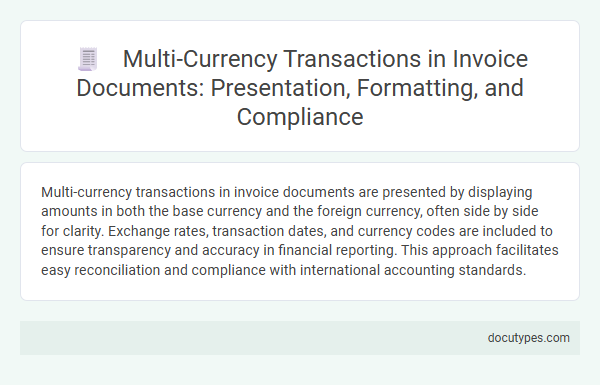Multi-currency transactions in invoice documents are presented by displaying amounts in both the base currency and the foreign currency, often side by side for clarity. Exchange rates, transaction dates, and currency codes are included to ensure transparency and accuracy in financial reporting. This approach facilitates easy reconciliation and compliance with international accounting standards.
Introduction to Multi-Currency Transactions in Invoices
Invoices involving multi-currency transactions present financial details in more than one currency to accommodate global business operations. Accurate representation of these transactions is crucial for clarity, compliance, and accounting purposes.
- Currency Identification - Invoices clearly specify the currencies used, including the base and foreign currencies, to prevent confusion in financial calculations.
- Exchange Rate Disclosure - The applicable exchange rate is documented to ensure transparency in currency conversion values.
- Dual Amount Presentation - Amounts are displayed in both the invoicing currency and the client's currency, facilitating easier reconciliation and payment processing.
Key Challenges in Multi-Currency Invoicing
How Are Multi-Currency Transactions Presented in Invoice Documents?
Multi-currency transactions in invoices require accurate currency conversion and clear display of amounts in both the base and foreign currencies. Key challenges include fluctuating exchange rates and ensuring compliance with international accounting standards.
Essential Elements for Multi-Currency Presentation
Multi-currency transactions in invoice documents are presented by clearly displaying both the original currency and the converted currency amounts. Essential elements include the currency codes, exchange rate applied, and the date of conversion to ensure transparency and accuracy.
Your invoice must include the total amount in the transaction currency alongside the equivalent value in your local currency. Showing the exchange rate used and the conversion date helps maintain clarity for accounting and auditing purposes. Accurate multi-currency presentation reduces confusion and supports compliance with financial regulations.
Formatting Guidelines for Multi-Currency Invoice Documents
Multi-currency transactions in invoice documents require clear formatting to ensure accuracy and transparency. Proper presentation helps both the issuer and recipient understand the financial details in different currencies.
- Currency Codes - Use standardized ISO currency codes (e.g., USD, EUR) to clearly indicate the currency for each amount.
- Exchange Rates - Display the exchange rate applied when converting between currencies to maintain traceability.
- Separate Amounts - Show amounts for each currency separately, including subtotals and totals, to avoid confusion.
Adhering to these formatting guidelines enhances the clarity and professionalism of multi-currency invoice documents.
Exchange Rates: Selection and Display Requirements
| Aspect | Description |
|---|---|
| Exchange Rate Selection | The exchange rate applied in multi-currency invoices must be current and sourced from a reliable financial institution or service. Selecting the exchange rate involves choosing the rate valid on the invoice date or the transaction date to ensure accuracy in currency conversion. This rate affects how amounts in foreign currencies are converted to the base currency. |
| Display Requirements | Invoices presenting multi-currency transactions must display the exchange rate clearly and prominently. The exchange rate should appear alongside the amounts in both the foreign currency and the base currency for transparency. It is essential to specify the rate's source and the date it was applied to help validate the conversions. |
| Transparency | Transparency in exchange rate information supports compliance and facilitates auditing processes. Your invoice documents should include detailed exchange rate data to avoid confusion and ensure that all parties understand the currency conversions involved in the billing. |
Reporting and Recording Multiple Currencies
Multi-currency transactions in invoice documents display amounts in both the original currency and the company's base currency, ensuring clarity in reporting. Exchange rates used for currency conversion are clearly indicated to maintain transparency and accuracy in financial records. This dual-currency presentation aids in consistent recording, enabling precise tracking of foreign currency exposure and financial performance.
Compliance Standards and Regional Regulations
Multi-currency transactions in invoice documents must clearly display the currency used for each transaction line, including the original currency and its equivalent value in the local currency. Compliance standards such as IFRS and GAAP require transparent currency conversion rates and exchange dates to ensure accuracy and auditability.
Regional regulations often mandate that invoices include detailed currency information to prevent discrepancies and support tax reporting requirements. You should ensure your invoices adhere to these guidelines to maintain regulatory compliance and facilitate smooth cross-border transactions.
Handling Taxes and Duties in Multi-Currency Invoices
Multi-currency invoices display transaction values in both the local and foreign currencies for clarity. Taxes and duties are itemized separately, reflecting accurate conversions according to exchange rates.
- Currency Conversion Accuracy - Taxes and duties are calculated using the prevailing exchange rate to ensure precise cost representation in each currency.
- Separate Tax Line Items - Invoices list taxes and duties distinctly, enabling transparent accounting and compliance with regional tax regulations.
- Dual Currency Display - Invoices present amounts in original and converted currencies to facilitate understanding for all parties involved.
Best Practices for Multi-Currency Documentation
Multi-currency transactions in invoice documents should clearly display both the original currency and the converted amount. Best practices include specifying the exchange rate used and the date of currency conversion to ensure transparency. Including currency codes, such as USD or EUR, alongside amounts helps avoid confusion and supports accurate financial reporting.
How Are Multi-Currency Transactions Presented in Invoice Documents? Infographic

